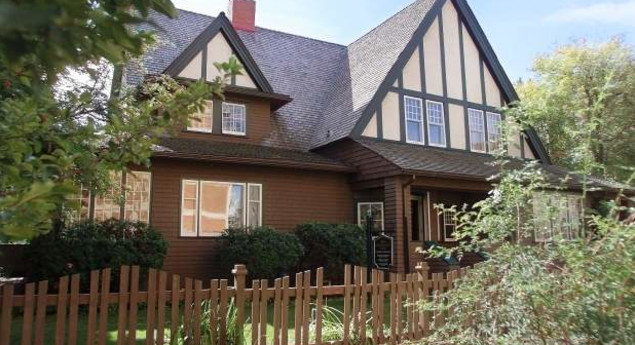The Nellie McClung House is an early twentieth century, one and one half-storey home situated on four landscaped lots in Calgary's Beltline community. The home features Tudor Revival architectural elements, including asymmetrical massing, half-timbering in-filled with stucco, and a steeply sloped roof.
The heritage value of the Nellie McClung House lies in its association with the determined and eloquent social activist, politician, and writer from whom the residence takes its name.
Nellie McClung was a determined and eloquent social activist, politician, and writer in western Canada. Born in Ontario, McClung came with her family to Manitoba as a child. As a young adult, she actively participated in the province's temperance movement and played a significant role in winning the women of Manitoba the right to vote. McClung moved to Edmonton in the mid-1910s and continued her career as a public intellectual and reformer. She established herself as a passionate and popular orator and author on issues like the evils of alcohol, the plight of the underprivileged, and the rights of women. In 1921, she was elected to Alberta's Legislative Assembly as a Liberal. Two years later, she moved to Calgary, commuting to Edmonton to fulfill her political duties. After her first term in office, McClung mounted an unsuccessful campaign to win election as a Liberal MLA for Calgary. Following her defeat, she dedicated herself to her prolific writing career, penning several of her popular novels and many of her essays and newspaper articles from the mid-1920s to the mid-1930s. In 1927, McClung joined with Emily Murphy, Henrietta Muir Edwards, Irene Parlby, and Louise McKinney - Alberta's "Famous Five" - to press for the right of women to be recognized as persons eligible for nomination to the Canadian Senate. The British Privy Council found in the group's favour in 1929 - a landmark ruling in the history of women's rights in Canada. McClung and her husband moved to Victoria in the mid-1930s, where Nellie continued her active public life, being appointed the first woman on the CBC Board of Governors in 1936 and serving as Canada's sole woman delegate to the League of Nations in 1938. Nellie McClung died in 1951.
The Nellie McClung House was likely built around 1900 and features a design and materials typical for the time and place. The home incorporates several elements from the Tudor Revival architectural style, including asymmetrical massing, half-timbering in-filled with stucco, and a steeply sloped roof. The Nellie McClung lived here from 1923 until the mid-1930s, one of Nellie's most active periods as an author.
Earn 10 points!
Photo: Images taken from The Calgary Herald.












